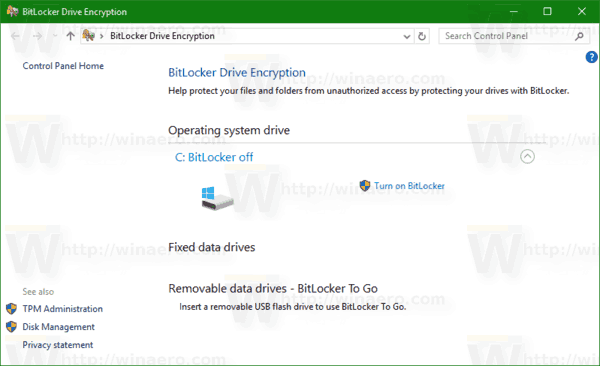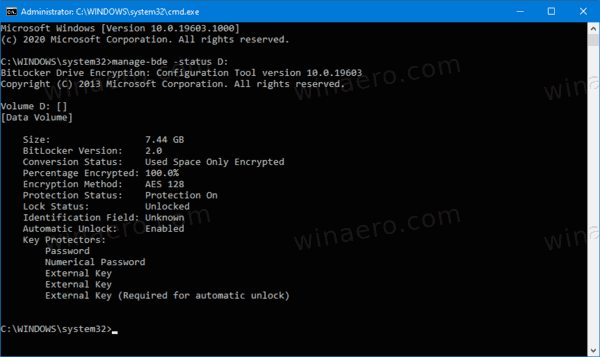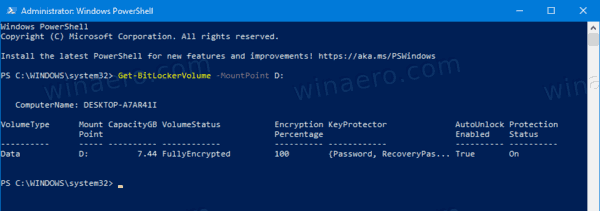How to Check BitLocker Drive Encryption Status in Windows 10
BitLocker is one of the key data protection technologies in Windows 10. BitLocker can encrypt the system drive (the drive Windows is installed on), and internal hard drives. The BitLocker To Go feature allows protecting files stored on a removable drive, such as a USB flash drive. Today, we will see how to quickly check if BitLocker is enabled for a drive, and which options were applied.
Advertisеment
BitLocker was first introduced in Windows Vista and still exists in Windows 10. It was implemented exclusively for Windows and has no official support in alternative operating systems. BitLocker can utilize your PC's Trusted Platform Module (TPM) to store its encryption key secrets. In modern versions of Windows such as Windows 8.1 and Windows 10, BitLocker supports hardware-accelerated encryption if certain requirements are met (the drive has to support it, Secure Boot must be on and many other requirements). Without hardware encryption, BitLocker switches to software-based encryption so there is a dip in your drive's performance. BitLocker in Windows 10 supports a number of encryption methods, and supports changing a cipher strength.

Note: In Windows 10, BitLocker Drive Encryption is only available in the Pro, Enterprise, and Education editions. BitLocker can encrypt the system drive (the drive Windows is installed on), internal hard drives, or even a VHD file. The BitLocker To Go feature allows protecting files stored on removable drives, such as a USB flash drive. Interested users can additionally change the encryption method for BitLocker.
Here are two ways in which you can learn BitLocker Drive protection status.
To Check BitLocker Drive Encryption Status in Windows 10,
- Open a new command prompt as Administrator.
- Type and run the command
manage-bde -statusto see the status for all drives. - Type and run the command
manage-bde -status <drive letter>:to see the BitLocker status for a specific drive. Substitute<drive letter>with the actual drive letter of your BitLocker protected drive.
The command provides the following details about the drive(s):
- Size
- BitLocker version
- Conversion status
- Percentage encrypted
- Encryption method
- Protection status
- Lock status
- Identification field
- Key protectors
Alternatively, there is a PowerShell cmdlet that you can use for the same task.
Check BitLocker Drive Encryption Status using PowerShell
- Open PowerShell as Administrator.
- Type and run the command
Get-BitLockerVolumeto see the status for all drives. - Type and run the command
Get-BitLockerVolume -MountPoint "<drive letter>:"to see the BitLocker status for a specific drive. Substitute<drive letter>with the actual drive letter of your BitLocker protected drive.
The Get-BitLockerVolume cmdlet information about volumes that BitLocker can protect.
You can also use this cmdlet to view the following information about a BitLocker volume:
- VolumeType - Data or Operating System.
- Mount Point - Drive letter.
- CapacityGB - Size of drive.
- VolumeStatus - Whether BitLocker currently protects some, all, or none of the data on the volume.
- Encryption Percentage - Percent of the volume protected by BitLocker.
- KeyProtector - Type of key protector or protectors.
- AutoUnlock Enabled - Whether BitLocker uses automatic unlocking for the volume.
- Protection Status - Whether BitLocker currently uses a key protector to encrypt the volume encryption key.
- EncryptionMethod - Indicates the encryption algorithm and key size used on the volume.
Support us
Winaero greatly relies on your support. You can help the site keep bringing you interesting and useful content and software by using these options:
